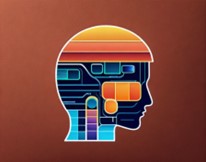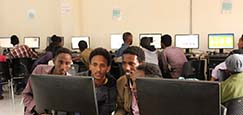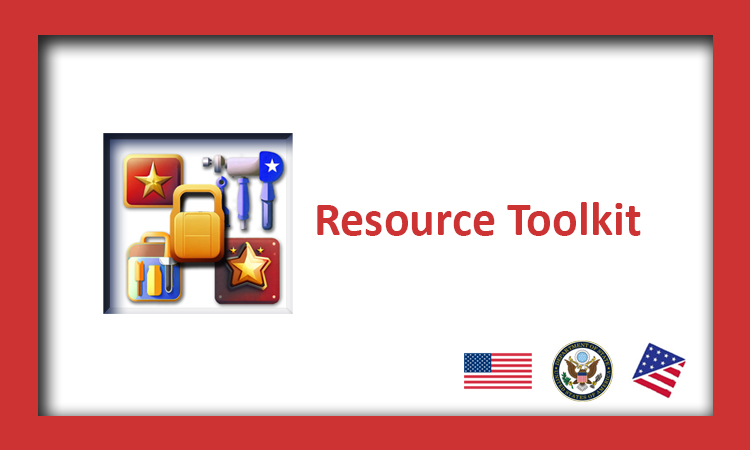ARTIFICIAL INTELLIGENCE IN EDUCATION
PROGRAM TOOLKIT FOR AMERICAN SPACES
This program toolkit is designed for programming at American Spaces to raise awareness of artificial intelligence and its use in education.



INTRODUCTION TO AI
Artificial intelligence (AI) is a technology that uses algorithms and machine learning to perform tasks that typically require human intelligence.
AI has the potential to transform many different industries and fields, and we are likely to see even more applications in the coming years.
In education, the subject of this toolkit, AI has the potential to transform the way students learn and teachers teach. By leveraging AI, educators can create personalized learning experiences, grade assignments more efficiently, and detect plagiarism.
However, it’s important to use AI responsibly and address potential social issues such as cheating. By doing so, we can unlock the full potential of AI in education.

EXAMPLES OF AI USE IN INDUSTRIES
Education: AI has the potential to transform the way students learn and teachers teach. By leveraging AI, educators can create personalized learning experiences, grade assignments more efficiently, and detect plagiarism.
Healthcare: AI is being used in healthcare to help with diagnosis, treatment, and patient monitoring. Machine learning algorithms can be used to analyze medical images and identify potential health risks or abnormalities.
Finance: AI is being used in finance to help with fraud detection, risk assessment, and investment analysis. Machine learning algorithms can be used to analyze large amounts of financial data and identify patterns that may be useful for making investment decisions.
Manufacturing: AI is being used in manufacturing to help with quality control, supply chain management, and predictive maintenance as well as uses for monitoring production processes and identifying potential issues before they become serious problems.
Retail: AI is being used in retail to help with customer service, inventory management, and marketing. Machine learning algorithms can be used to analyze customer data and make personalized product recommendations.
Transportation: AI is being used in transportation to help with route optimization, vehicle maintenance, and safety. Machine learning algorithms can be used to analyze traffic patterns and identify the most efficient routes for vehicles.
Is it cheating?

The use of AI in doing homework is a controversial topic, with arguments for both learning and cheating. Some believe that using AI tools to assist with homework can help students learn by providing them with new ways of thinking about problems and solutions. Others argue that relying too heavily on AI can lead to a lack of critical thinking skills and understanding of the material. Ultimately, the effectiveness of AI in doing homework depends on how it is used and the balance between relying on technology and developing one’s own abilities.
PODCAST
AI in Education
Sidney is Scary 1:09:03
RESOURCES
- PBS Discussion Guide on AI
- “AI in Education: Opportunities, Challenges and Ethical Implications” by UNESCO
- “Artificial Intelligence and the Future of Education” by the OECD
- “How AI is changing teaching and learning” by Microsoft Education
- Did my student use AI for the assigned report?
- The Impact on Communications in AI World
- password: gpa2023


ISSUES FOR DISCUSSION (AI IN EDUCATION)
Personalized Learning: AI can help create personalized learning experiences for each student by analyzing their learning patterns and adapting the curriculum accordingly.
Lesson Planning: AI can analyze student performance data and generate insights that can be used to create lesson plans that are tailored to individual needs.
Grading Assignments: AI can be used to grade assignments, freeing up time for teachers to focus on other tasks.
Plagiarism Detection: AI can detect plagiarism by comparing student work to a database of existing work.
Benefits of AI in Education
There are many benefits of using AI in education. Here are a few examples:
- Improved Learning Outcomes: By providing personalized learning experiences, AI can help improve learning outcomes for students.
- Increased Efficiency: By automating tasks such as grading and plagiarism detection, AI can save teachers time and increase their efficiency.
- Reduced Workload: By automating tasks, AI can reduce the workload on teachers, allowing them to focus on other tasks.
Potential Social Issues
While AI has many benefits, there are also potential social issues that need to be addressed. One concern is that students may use AI to cheat or replace actual learning. To mitigate this issue, it’s important to educate students on the responsible use of AI and to implement measures to detect and prevent cheating.
QUESTIONS FOR DISCUSSION
- How can AI be used to enhance student learning in the classroom?
- What are the potential benefits and drawbacks of using AI in education?
- How can teachers integrate AI into their lesson plans effectively?
- Will AI eventually replace human teachers? Why or why not?
- How can AI be used to personalize learning for individual students?
- How can AI be used to promote student engagement and motivation in the classroom?
- What ethical concerns should be considered when using AI in education?
- How can AI be used to assess student learning and provide feedback?
- How can AI be used to improve access to education for students in underserved areas?
- What skills and competencies do teachers need to effectively use AI in the classroom?
The views expressed in these resources do not necessarily represent those of the U.S. government. Most text in this toolkit was generated by AI. All images were generated by AI.
Updated May 2024









